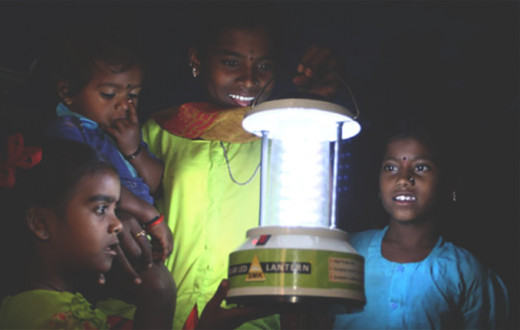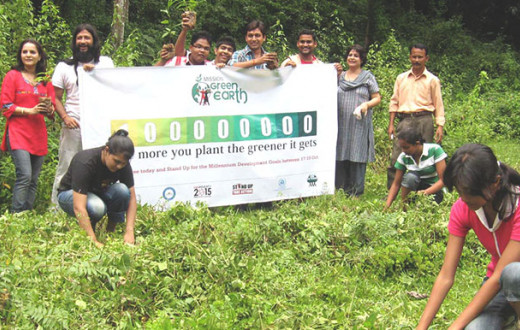Is every other year’s resolution, but only this time a precious reality. Ujval Shankar, the initiator of the campaign, Stop Smoking, Start Living, shares the time he crossed over and came out clean on the other side, “I joined the Art of Living about eight years ago (in 2003), because prior to that, for 11 years, I was a hardcore smoker, alcoholic and a lot into drugs. I got into the habit because of friends and the circle I was being with and the hotel industry I was working for at that time.
Then, in 2002, a friend of mine saw me and told me that I should do this course. But I said, I’m the last one to do this program - I’m not going to get into a guru concept, but then he saw my health deteriorating and I needed it very badly because my parents were giving up on me and I was also planning to go to a rehab for my habit. Plus, I suddenly got into a mode wherein I felt this is not real - this is not the reality of life.”
That’s when he decided to give the course a try, “But in order to make sure I don’t get tempted to smoke during the course, I decided not to carry the pack of smokes to the ashram and I was lucky that Guruji was there in the ashram at that time.
The first day and the first kriya were fine. But the second day, something just shook me inside and said, ‘This is it’ and I was really thankful. I had tears in my eyes and I was crying for half an hour about the course,” beams Ujval, looking healthy and fresh after an evening satsang (in Sanskrit, sat = true and sanga = company, which involves the company of the highest truth and the guru) in the Bangalore ashram.
Even after he completed the course, he continued to smoke, says Ujval, “But with regular practice, I quit everything - smokes, alcohol and even meat in 10 days. It was very easy - it wasn’t something that was forced on me and I never imagined that just breathing could help me so much.”
Soon, he did his advance course and DSN and got closer to the Master, whose knowledge kept him away from addictions and helped him improve his relationships with friends and family, smiles Ujval, “Initially, my friends were surprised and they told me, ‘You’re the one who got me into this habit and how can you come out it now’. But I didn’t feel the need to smoke or drink and encouraged some of my friends to kick the habit because ultimately, everyone wants to get out of it.”
This persistent thought inspired him and a few others to start a theme-based program, especially for smokers in 2006-2007, explains Ujval, speaking straight into the dictaphone, his voice gentle and unhurried, “Somewhere I felt it was so easy to relate to them because you were in that habit and you realize that everyone needs support.
The best part about this program is that there aren’t too many things that restrict you - you can still be into the habit. But then, people are now experiencing how it aides them to come out easily.”
Each participant is expected to get an ECG done at the beginning of the course, says Ujval and, “Everybody knows that they need to quit the habit in seven days and it’s an eight-day program; it’s a little longer than the normal basic course. There’s very intense breathing, pranayamas and of course, the Sudarshan Kriya, which is the core of this program, along with a lot of group therapy - people get into groups and talk about how they can quit the habit and what they need to do about it.”
Plus, a lot of focus is on their diet, shares Dr. Vedumurthy, the science behind staying clean, “We ask them to add a few things to their diet - mostly milk products and sweets, which will reduce their anger and anxiousness. In addition, we give them ayurvedic medicines, tulsi tea and recommend them to eat bananas and simple, satvik food and leave meat during the duration of the course,” and re-enforce the need to quit smoking by sharing videos and pictures about the repercussions of the habit, and, “Two days after the Sudarshan Kriya, about 90 per cent of them quit smoking. In a week, most of them quit,” shares Dr. Vedumurthy, confidently, to which Ujval adds, “With smokers, it’s the craving. The best thing is people call each other as buddies when they have strong urges for a smoke during and after the course and when they talk and postpone that - people who used to smoke 40 cigarettes a day come down to six or seven cigarettes. It’s been a massive change.
The biggest reaction has been that of their families - a lot of wives call up and say, ‘Listen, my husband needs to do this program’ and a lot of women also join the course - it’s an equal number.”
Today, Ujval and a few other volunteers walk into pubs and cafés and pass around cards that read, Stop Smoking, Start Living - Join The Special Art of Living Course and, “People actually drop their cigarettes when they see this card and thank us. They feel so shy about it. We don’t force them at that moment but mostly, people call us back. We don’t want to force it on them because the first step is that you realize and come forward,” smiles Ujval and gently informs, “It’s not easy to come out of smoking because cigarette is the only thing easily available. You can come out of drugs and alcohol, but not smoking because you can go out, have a smoke, clean up and nobody knows. But if you are not regular with the Sudarshan Kriya, you can go back (to the habit).
That’s why we have special follow-ups and we quickly enroll them for an advance course or DSN. Sometimes people who are used to 40-45 cigarettes a day come down to two or three cigarettes after the first course. But after they do the advance course, they are completely out of it.”
But how is it different from any other course, “I’ve seen a lot of campaigns on the internet that talk about ways to quit the habit but there is no practical experience to it - nobody gets into a course. The worst thing is to get into a rehab and be there for 20-25 days in that environment. I feel nobody discusses the practical aspect of breathing - when your toxins come out. People have alternatives - nicotine gums and patches, but its all just temporary. But when they come on the course, meet similar people and experience changes together, it’s very different,” answers Ujval, taking us through some of the experiences his students have had, “One of the participants - a father, after he finished the course said, ‘After so many years, my daughter has come close to me. Earlier, she couldn’t take the smoke smell. But today, I’m so clean that she wants to hug me and be next to me’.
Another one had been smoking for 42 years, but within eight days, he came out of the habit and his health has improved so much.
Also, there was a young girl (in her late 20s) who had been smoking for years and had relationship issues and a divorce. While she was sharing her experience, she said, ‘I’ve actually learnt to breathe after the course and now, I can look forward to life’.
At the end of the course, they all look so fresh and they are actually looking at life beyond a puff of cigarette.”







